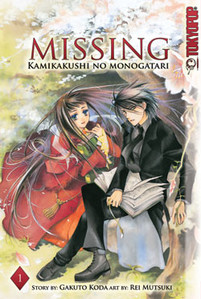Review
by Carlo Santos,Missing: Kamikakushi no Monogatari
GN 1
| Synopsis: |  |
||
Kyoichi Utsume is a mysterious young man who always seems to be off in a world of his own. Even his schoolmates in the Literature Club have nicknamed him "His Majesty, the Lord of Darkness" because of his aloof demeanor. However, Utsume's behavior seems stranger than usual when he introduces his new girlfriend Ayame—a girl that he's only known for one day. The other Literature Club students start to wonder if something is amiss, and their suspicions turn out to be right when Utsume goes missing the next night. Their only clue to finding him lies in understanding Utsume's past—and uncovering Ayame's true nature! |
|||
| Review: | |||
There's something to be said for manga adaptations of novels. On the surface, Missing may look like typical horror-fantasy fare (the author even labels it as such), but it carries a certain subtlety and atmosphere thanks to its prose-fiction roots. Unfortunately, subtlety and atmosphere are about the only things it's able to bring to this compact 160-page package, as the volume cuts off before the story has a chance to develop further. Within these pages, however, are the seeds of promise: a mystery grounded in folklore and legend, an intriguing set of characters, and free-flowing artwork that reflects the surreal nature of the spirit world. Whether it can deliver on that promise is a question that remains to be answered in the rest of the series. The opening chapters of this volume are easily the weakest part of the story: they dwell too much on day-to-day school life, and while that's good for establishing the setting, it's also fantastically boring. The members of the Literature Club seem like conveniently assigned stereotypes, and the worst part is that the lead characters are bouncy scatterbrains straight out of a generic teen comedy. Even Utsume is shown as some kind of brooding goth caricature, and not the mysterious soul that he turns out to be later. Vapid dialogue and gossip, as well as a featureless school setting, make the first half of this story a test of endurance. Luckily, good things come to those who wait, especially once the mysteries start piling on. Ayame's strange nature is shown in brief lapses, just enough to pique one's curiosity—she has a way of showing up out of nowhere, fooling not just the characters but also the reader—and once Utsume goes missing, the plot really starts to kick in. Even the lead characters lose their fake cheeriness as they get spooked out and dig into the mystery. The last 80 or so pages of the book are an intriguing blend of occult elements: the Literature Club students start investigating Utsume's past, bringing up the idea of childhood ghost encounters, and when they start looking up other books on folklore and urban legends, they stumble upon a paranormal concept that provides the whole foundation for the story. This is where the good stuff begins, but it's also right where the volume ends—thus leaving it as more of a lightweight prologue than a fully fleshed-out plotline. Despite the story's rocky start and its abrupt cutoff point, the artwork still gets enough space and time to establish the series' gently unsettling mood. Nowhere is this better accomplished than in the chase scene with Ayame, as she repeatedly disappears behind corners and disorients just about everyone. The point of the art is to purposely feel confused and lost at times, as the characters get tangled up in mysteries they don't understand. Loose layouts also capture that lost feeling, especially when the panels break up and images start to float over each other—a dramatic moment of convergence between real and spiritual worlds. However, moments like these are often outnumbered by scenes of artistic blandness, especially in the opening chapters (could the school environment be any more generic?) and with the forgettable character designs. Don't expect a high level of visual polish and craftsmanship here; the occult atmosphere is about the only thing that's done right. Not surprisingly, the early scenes are where the dialogue and its translation are weakest—not only is the writing loaded with high school clichés ("Gosh! Isn't it nice to have a boyfriend or girlfriend!"), but some snippets of dialogue are so long that the font is forcibly shrunk to fit inside the bubble. Fortunately these reading nightmares go away once the mystery aspect of the story comes to the fore; the ghost stories and tales of Utsume's childhood read much more smoothly. Sound effects are sparse in this book, but the few that do exist are about half-translated—if it's essential to the story, then an English sound effect shows up as a replacement, but other times the original Japanese is left alone. It's kind of a cheap effort, which is also suggested by the lack of bonus material and somewhat thin pages. In a world where "supernatural manga" is often synonymous with "episodic monster-hunting adventures", it's nice to see a story like Missing that breaks the mold. Although the concept isn't totally original, it definitely has a different feel from other entries in the genre. It's a feeling of quiet mystery, of a spirit world just beyond the knowledge of ordinary humans. However, this feeling doesn't develop until about halfway through the first volume, and then it closes out on a cliffhanger just when the story has started to kick off. Not the most positive start, but good enough to keep folks hooked for Volume 2—which is, hopefully, where things will really start to get interesting. |
| Grade: | |||
|
Overall : B-
Story : B
Art : B-
+ A quiet, mysterious mood bolstered by loose, dreamlike artwork. |
|||
| discuss this in the forum (4 posts) | | |||